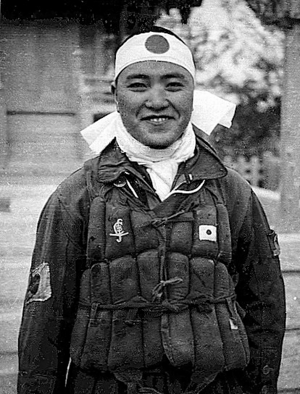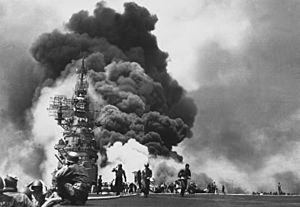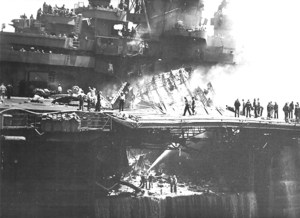Kiyoshi Ogawa facts for kids
Quick facts for kids
Kiyoshi Ogawa
|
|
|---|---|

Ogawa wearing a hachimaki
|
|
| Born | October 23, 1922 Usui District, Gunma Prefecture, Japan |
| Died | May 11, 1945 (aged 22) USS Bunker Hill, near Okinawa, Ryukyu Islands |
| Allegiance | |
| Service/ |
|
| Years of service | 1944–1945 |
| Rank | |
| Unit | 721st Kōkūtai |
| Battles/wars | World War II |
| Awards | Died in battle award |
Kiyoshi Ogawa (Japanese: 小川 清 Ogawa Kiyoshi, October 23, 1922 – May 11, 1945) was a Japanese naval pilot during World War II. He was an ensign, which is a junior officer rank. Ogawa became a kamikaze pilot. These pilots flew planes packed with bombs and crashed them on purpose into enemy ships.
Ensign Ogawa's last mission was on May 11, 1945, during the Battle of Okinawa. He flew a Zero fighter plane loaded with a bomb. He flew through American anti-aircraft fire and attacked the U.S. Navy aircraft carrier USS Bunker Hill. This happened less than a minute after another kamikaze pilot, Seizō Yasunori, hit the same ship. Ogawa dropped a 550-pound (250 kg) bomb and crashed his plane deliberately into the flight deck near the control tower.
The bomb went through Bunker Hill's flight deck and exploded. This caused large gasoline fires and more explosions as planes on the deck caught fire. In this attack, 393 American sailors died, 264 were wounded, and the ship was so badly damaged it could not be used for the rest of the war.
Contents
Early Life and Education
Kiyoshi Ogawa was born on October 23, 1922. He grew up in Usui District in Gunma Prefecture, Japan. He was the youngest child in his family. Kiyoshi was a good student and later attended Waseda University in Tokyo.
Military Career in World War II
After finishing his studies, Ogawa joined the military as a "student-soldier" (gakuto). This was a college student who became a soldier or officer during their time at university. He received training to become a pilot. College graduates like Ogawa often had broader ideas about the world because they had not been trained only in military schools.
During training, some officers were harsh towards student soldiers. Many reserve students faced daily physical punishment for even small mistakes.
Ogawa finished his flight training and became an ensign. He was then assigned to the 306th Fighter Squadron. This squadron was part of the Imperial Japanese Navy's 721st Kōkūtai (Air Group) at Kanoya.
Volunteering for Kamikaze Missions
Ogawa later volunteered for the Imperial Japanese Navy Kamikaze Special Attack Force. This force was also known as tokubetsu kōgeki tai.
Pilots could volunteer in two ways. One was a general application for all pilots. The other was a special survey for college graduates like Kiyoshi Ogawa. This survey asked: "Do you desire earnestly/wish/do not wish to be involved in the Kamikaze attacks?" Ogawa had to choose one of these options or leave it blank. The military knew that college students might not volunteer easily. Because of this, some college graduates who did not want to volunteer were pressured to choose "desire earnestly" in the survey.
Many students from Japan's top colleges, such as Tokyo, Kyoto, Keio, and Waseda, became kamikaze pilots during World War II.
Ogawa's Kamikaze Attack on Bunker Hill
On May 11, 1945, the aircraft carrier USS Bunker Hill was involved in naval operations. It was about 76 miles (122 kilometers) east of Okinawa, helping with the invasion there. Bunker Hill was the main ship for Vice Admiral Marc Mitscher. The ship had been at sea and in constant action for 58 days.
That morning, the Imperial Japanese Navy launched a huge kamikaze mission. It was called Kikusui Rokugi Sakusen, or Operation Kikusui "Floating Chrysanthemums" No. 6.
Off the coast of Okinawa, Ogawa and his squadron leader, Seizō Yasunori, who also flew a Zero, spotted Bunker Hill. At 10:04 AM, a Marine pilot named Captain James E. Swett quickly radioed: "Alert! Alert! Two planes diving on the Bunker Hill!"
Ogawa and his leader dove towards Bunker Hill so fast that the ship's gunners barely had time to react. At 10:04 AM, Ogawa's leader released a 550-pound bomb. It crashed through the flight deck and out the side of the ship, exploding just above the water. His plane then crashed onto the flight deck and slid off the side. This destroyed almost all of the 34 fully armed and fueled planes parked on the deck.

At the same time, Ogawa was finishing his dive through the anti-aircraft fire. He aimed for the flight deck near the ship's bridge, where he could cause the most damage. Kamikaze pilots were trained to hit these vital areas. At about 10:05 AM, Ogawa dropped his 550-pound bomb just before hitting the flight deck near the island (the ship's control tower).
The 550-pound (250 kg) bomb went through Bunker Hill's flight deck and exploded. This caused large gasoline fires and several more explosions. The bomb did not go through the hangar deck below, which helped protect the ship's important machinery. Essex-class ships like Bunker Hill had strong armored decks to stop bombs from reaching vital areas.
Ogawa's bomb made a big hole in the flight deck near the bridge. Vice-Admiral Mitscher, who was on the flag bridge, barely escaped. However, he lost twelve of his staff officers, including his medical officer.
Many of Bunker Hill's pilots died during the attack. For example, 22 fighter pilots from the ship's air group were killed in the ready room. The bomb's explosion quickly burned up all the oxygen in the room, causing them to suffocate.
With his ship badly damaged, Vice Admiral Mitscher decided to leave. The destroyer USS English came alongside Bunker Hill to help fight the fires and to take Vice Admiral Mitscher off. He then moved his command flag to the carrier Enterprise.
Of Bunker Hill's crew, 352 were killed, 264 were wounded, and 41 were missing. Hundreds of crewmen were either blown overboard or had to jump to escape the fires. Captain James E. Swett gathered about 24 circling airplanes, mostly F4U Corsairs. They dropped dye markers and Mae Wests (life vests) for the crewmen swimming in the oily water around the damaged carrier.
Bunker Hill was eventually saved. The damaged carrier sailed 4,300 miles (7,000 km) to Puget Sound Navy Yard on its own power. When it arrived, it was called the "most extensively damaged ship" ever to enter the yard. Its repairs took the rest of the war.
According to Robert Schock, a U.S. Navy diver on Bunker Hill, Ogawa's plane was not completely destroyed. It remained partly intact on the hangar deck, half in water, with live wires sparking. Schock found Ogawa dead in the cockpit. He removed Ogawa's name tag, a letter, some photos, a belt from his parachute, and a large aviator watch from Ogawa's body.
Legacy
On March 27, 2001, Kiyoshi Ogawa's grandniece, Yoko Ogawa, her mother, and Masao Kunimine, an old college friend of Kiyoshi Ogawa, received these personal items. This happened in San Francisco, almost 56 years after Operation Kikusui No. 6.
See also
 In Spanish: Kiyoshi Ogawa para niños
In Spanish: Kiyoshi Ogawa para niños


